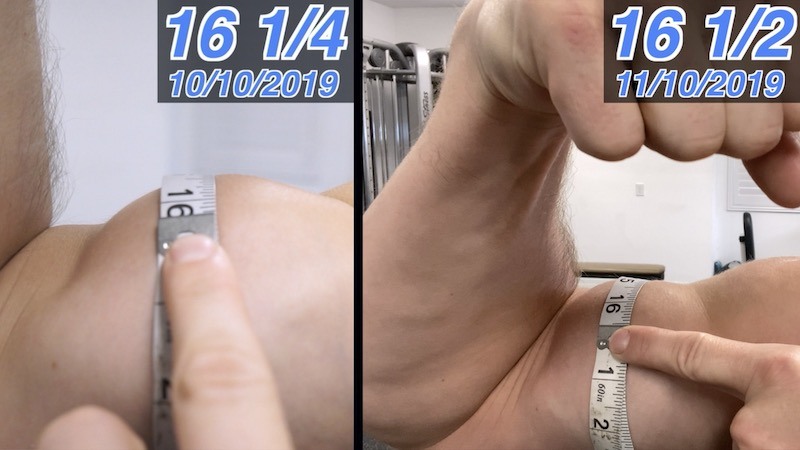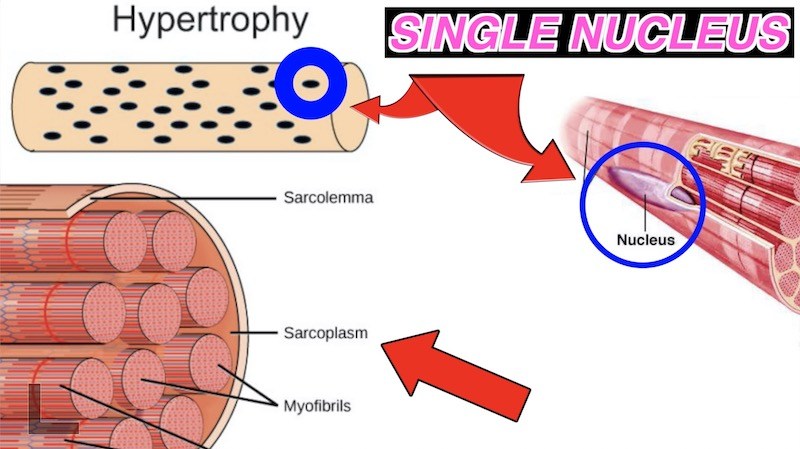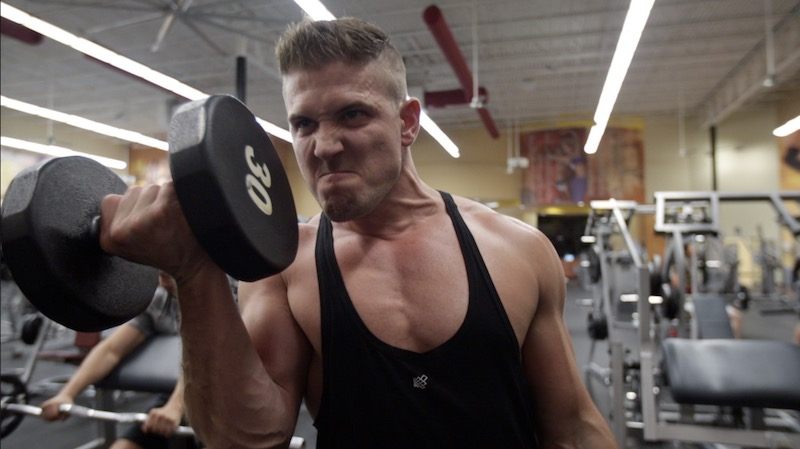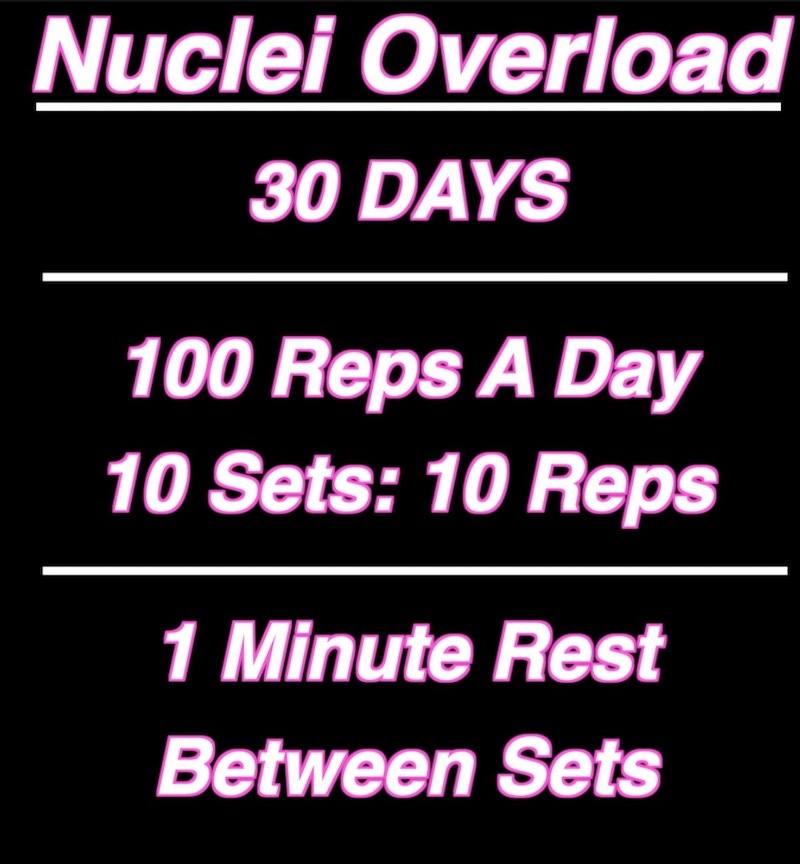I Did 100 Bicep Curls Every Day For 30 Days
Nuclei Overload Training
As you know I decided to experiment with Nuclei Overload Training to try to spark more growth in my biceps! Compared to all my other muscles, I’ve always felt like my biceps are lagging and if what I’ve been doing wasn’t working, trying something else seemed like the best alternative. So I decided to give Nuclei Overload Training (NOT) a shot and what I did was perform 100 dumbbell biceps curls a day for 30 days straight.
Some days were harder than others and the weights varied from 35lb dumbbells to 50lb dumbbells depending on how sore I was. Also, I wasn’t pumping out 100 reps in a row. I was completing 100 reps as fast as I could, usually in 10 sets of 10 reps. The reason is because I didn’t want to have to go TOO light. Call me stubborn, but even though I’m loading up on volume I still felt like I needed a bit more stimulation than just curling 10lb dumbbells 100 times in a row. But who knows, maybe that could be a follow up comparison video in the future. If done correctly though, it should only take about 15 – 20 minutes to complete and if let’s say I started with 50lb dumbbells but then my arms began to fatigue A LOT, I would just drop the weight to 45lbs, 40lbs or 35lbs, whatever I needed to do to keep the rest periods under 1 minute.
But the REAL QUESTION is, why did I wait SO LONG to show you my results as I did this from October 10th through November 10th. Well, The holidays were a big part of it. I had all kinds of family visiting from Brazil for Thanksgiving, Christmas and New Years and because I’m also building a pool, the last 3 weeks have been full of design work, lots of shoveling to redo my irrigation lines and just random other stuff. However, the biggest reason is that a HUGE PART of NOT is the RECOVERY after the 30 days and I wanted to be able to talk about that as well as have time to research the science as well.
To be honest, I want to continue with NOT for other body parts, but always use this video as a point of reference so I don’t have to re-explain everything, every time.
Did My Biceps Actually Grow?!
FIRST THINGS FIRST, did my biceps ACTUALLY GROW?Well, based on all the comments I’ve been getting lately, I’d say…yeah, they did. In fact, I noticed about a quarter inch difference when I remeasured from day 1 to 30 days later and still retain that difference even now. Also, when I first mentioned I was going to try NOT, a few people commented that any size difference would just be “inflammation”, not real growth, and would “go away” after a long rest period. So at face value I can say to those people, HELL YEAH, NOT DOES work! But that wouldn’t be very scientific would it? Let me explain.

There’s a lot more to this than just “seeing” growth. You have to take into consideration THREE very important things as well.
- Newbie Gains (which doesn’t really apply to me but should still be noted)
- Muscle Memory (which DOES apply to me and I will explain why)
- Actual growth obtained from additional myonuclei in the muscle
What The Research Says About NOT
Now, I did quite a bit of research on NOT and for the most part a lot of people are saying the same things. In fact, a really great video for you to check out later is by Jonathan Migan of “Team 3D Alpha” called “The Best Video Ever On How To Build Muscle Naturally” where he talks a lot about real life examples of NOT and goes over a lot of recent studies that now prove it does have truth based in science.
Some of my favorite parts of the video is when he talks about being a kid in West Africa and seeing the merchants who would ride bikes up and down hills everyday with all their merchandise and even though they were under-eating and thin in their upper body, their legs were still really developed, especially their quads. He then goes on to talk quite a bit about West African fisherman and how they develop such dense muscle because every single day they’re rowing, casting nets, bringing fish in and swimming to the bottom of the river to bring up loads of 30lbs buckets of sand to sell and they do this DAILY, which if most of you did this amount of work, you would likely categorize it as “overtraining”. But this is just life for them and don’t pull the “It’s because they have black genetics” card, because that’s just ignorant as not everyone in West Africa is born shredded with super dense muscle mass. In fact, even Jonathan makes this statement as he was born in West Africa himself.
Some other real life examples include powerlifters. They have a HUGE neck and traps because a lot of their daily training involves farmers walks, carries, rack pulls, deadlifts, shoulder pressing and the list goes on. They don’t just train these movements once a week.
Dancers have insane legs, glutes and calves from daily dancing, gymnasts have incredible shoulders, back and biceps from all the bar and ring work they do daily, Olympic skaters have HUGE legs from skating daily and even Arnold said that to bring up his calves, because they were a lagging body part, that he trained them daily. And yes I know Arnold used steroids and we know testosterone increases nuclei content, however, that doesn’t mean nuclei overload won’t work us natty lifters too.

Newbie Gains
So getting back to my list, let’s start with #1 which is NEWBIE GAINS and I’m going to do my best to keep my explanations as simple as possible.

Take a look at this image. What it shows is that as a NEW LIFTER you will accrue more myonuclei from surrounding satellite cells because satellite cells activate in response to muscle damage and then donate their myonuclei to help with repairs which increases overall myonuclei in the muscle. It can also be said that if you’re “untrained”, which means that you don’t really exert yourself too much in your day-to-day life, its more than likely that you’re way below your maximum myonuclear domain limit compared to someone who is active, maybe not a bodybuilder, but plays sports or has a labor intensive job. This is why new lifters grow quicker.
There’s actually a really interesting talk about “myonuclear domain theory and hypertrophy” on the StrongerByScience podcast with Greg Nuckols that you can check out HERE.
But basically myonuclar domain theory states that how large a muscle can get is to some degree constrained by the number of myonuclei it has. Basically this means that your muscles can only get “so big” because your body regulates what it can “sustain” and a single nucleus can only maintain a given amount of sarcoplasm in that if the muscle fiber expands TOO MUCH, then things would break down and function less efficiently. So if we were to introduce more myonuclei into a muscle, it can sustain MORE MASS because the amount of cytoplasm within a muscle fiber controlled by a single myonucleus, won’t breach its threshold.

But how do you accomplish this once the NEWBIE GAINS phase is over? Or to be even more specific, how do you surpass this NATURALLY once you reach your NATURAL LIMIT. Well, let me post this question to all of you.
Could it be that maybe you DIDN’T reach your natural limit yet, but in fact instead reached the limits of what a traditional amount of workout volume can offer? Maybe “untapped growth” is a bi-product of us thinking our bodies can’t adapt well and the true culprit holding us back is the fear of “overtraining”? A compelling argument right? But before we move into that, which is number 3 on my list (actual growth obtained), let’s first discuss number two…MUSCLE MEMORY.
Muscle Memory
Now, the reason why I’m bringing up muscle memory in this video is because my arms used to be a lot bigger a few years ago.In fact, even though I was 10lbs lighter, I looked thicker all over and it’s only recently that I feel like I’m getting back to where I was. For example, take this video filmed back in June of 2013.
I look much thicker in my chest, arms and shoulders and it’s for a few reasons. Number one, I had an INCREDIBLE PUMP when I filmed that video. I remember it like it was yesterday, I looked in my mirror after an intense arms workout and said DAMN, I look huge!! I need to film a video, RIGHT NOW!! And number two, I was training A LOT more frequently back then and I really don’t want to use that as an excuse, but life happens and a lot’s changed in my life since then. Not bad things, just overall healthy “adult life” growth. But back to my point, if we refer to the photo from earlier,

After the GROWTH stage, the muscle is not only bigger, but also contains much more myonuclei. But then as your training volume decreases, it’s possible for the muscle to get smaller, but still retain the same number of nuclei. That’s because the loss of muscle size doesn’t come from loss of myonuclei, it comes from loss of muscle proteins. Of course “muscle atrophy” is always a fear as well, but I didn’t STOP training, I just wasn’t nearly as consistent as I was back then. So in my case, I would say the last 6 or 7 months have been the best dedication to training I’ve had in YEARS and I know I can still do even better.
So did my biceps REALLY grow a quarter inch?Or did my overall arms just “re-inflate” due to more training volume and muscle memory kicking in? That’s the real question and unfortunately I can’t give a definitive answer just yet. Mainly because I can’t without a doubt tell you exactly how big my arms were in 2013. I know I weighed 172lbs and I’m 183 – 185lbs now. But I don’t want to lie to you guys for the sake of views on a video.
Actual Obtained Growth
However, this does lead us into number three on my list which is “actual obtained growth” from additional myonuclei in the muscle and this is where the science behind the LONG REST PERIOD comes in and why I waited so long to make this video. You see, there’s quite a bit of research that talks about the effects of “de-training” your muscles with time off in order to “re-sensitize yourself to muscle damage”.

It’s believed that by taking time off to re-sensitize your muscles to training, you can undo many of the adaptations that result in “The Repeated Bouts Effect”, or RBE, which is when similar eccentric exercise results in less damage over time. Remember, your body is SMART and is always trying to become more efficient with repetitive tasks. It doesn’t know you’re lifting weights trying to get “bigger”. Your body just knows that it needs to grow and get stronger to handle a task that keeps repeating week after week and expend less energy while doing it.
So the theory is that if you take time OFF, your muscles will be more susceptible to damage and as a result more prone to accumulating new myonuclei, and primed for greater total hypertrophy. Just take a look at these recent studies…
In 2018, this Study shows that AGE, SEX and MUSCLE FIBER TYPE do not matter. If you begin to train you are increasing myonuclear content: https://www.ncbi.nlm.nih.gov/pubmed/29509639
Another study in 2018 by Brad Schoenfeld demonstrates that high frequency training is more optimal in terms of hypertrophy gains than training once a week. So basically full body splits Vs. bro splits which is something the majority of us already know and accepted to be true: https://www.ncbi.nlm.nih.gov/pubmed/27102172
But then the information collected was taken one step further in a more recent study in 2019 where two groups of men were given the same amount of TRAINING VOLUME, but one group consisted of traditional SPLIT training where the other did full body workouts. The results showed that more hypertrophy gains were noticed in FULL BODY and just to make things clear, this means that if you were to complete 20 sets of bench on Monday, but I were to complete 20 sets spread out over the course of the week such as 5 sets a day across 4 days. I would grow at a much faster rate: https://www.ncbi.nlm.nih.gov/pubmed/31260419
Is Full Body Training The Answer?
But what does this REALLY mean? Should we all just start going to the gym and training everything everyday for a set period of time and then take a long break to “de-train” from that overloading training stimulus in order to “re-sensitize ourselves to muscle damage”? Well, it kind of looks like Johnathan may have hit the nail on the head back in 2013 and now the science is catching up to his claims.
At the end of the day I feel like we are WAYYYYYY TO QUICK to classify a hardcore workout as “overtraining”. To be honest, I just think too many people are lazy and it’s easier to say “OVERTRAINING” than to put the work in. Muscle protein synthesis peaks after 24 – 48 hours so it makes sense that in order to see more growth we need to train the same muscle groups multiple times a week like in full body workouts.
But when it comes to training, it’s going to be a matter of finding that sweet spot of the “perfect” amount of daily volume to maximize your gains. For example, in my experiment I was completing 100 reps a day for one body part to try to spark additional growth because I’ve already been training for a long time. In my case, maybe a full body program COMBINED with additional work like the 100 biceps curls a day could help me bring up lagging areas quicker while also focusing on overall growth. Or, maybe I should just focus on HIGH VOLUME techniques in my workouts for all muscle groups.
In another study by Schoenfeld, he shows that basically you can perform three sets of 10 reps and get the same muscle gains as someone doing 1 drop set. But what does that mean? Well for one you can get the work done faster. Instead of resting between your sets of 10 reps, you just drop the weight and keep going until all 30 reps are complete. It also means you can achieve the same gains with lighter weight which means less chance of an injury: https://www.ncbi.nlm.nih.gov/pubmed/28474868
What I’ve Learned
I know that there was A LOT in this article. But if I’m being honest, I’m excited in a way I haven’t felt in a long time. Remember when I said “maybe you DIDN’T reach your natural limit yet, but in fact instead reached the limits of what a traditional amount of workout volume can offer?” Well then maybe that means there’s A LOT more hope for myself and all my fellow natural athletes out there who want to take their training and gains to the next level and the equation looks simple enough.
Train like Vegeta for a month straight, active rest or deload for a solid 12 – 14 days to de-train your body, then right back to more intense training! Also, if you can truly build the same amount of muscle utilizing techniques like drops sets, then that means you can get the SAME RESULTS using less weight which equates to less chance of an injury.
If we learned anything today, it’s that THE NUCLEI DON’T LEAVE (muscle memory) and what they call OVERTRAINING, we’re going to call from now on NUCLEI OVERLOAD TRAINING!!!

Conclusion
One last thing – since completing the 100 reps a day for my biceps, whenever I train back or perform biceps movements, the pump and mind-muscle connection has been better than ever. It’s super noticeable both visually and physically inside my own body. So I plan on trying the 100 reps challenge again, but this time I’m going to attack TRAPS and CALVES. Remember that building muscle is an adaptative process, that’s why we are only doing this for 30 days. So if you didn’t get in on BICEPS, lets hit traps and calves together with POWER SHRUGS and BARBELL CALF RAISES!








